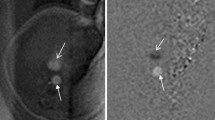Abstract
Multiple-fetus gestations have an increased risk of discordant anomalies, aneuploidy and growth restriction compared to singleton pregnancies. In addition, twins sharing the same placenta are at risk for developing specific conditions that are potentially amenable to surgical management. In those scenarios, patients might need to be evaluated not only with US but with fetal MRI as well. This paper outlines basic guidelines to consider when imaging complicated multiple-fetus gestations during the 2nd and 3rd trimesters.



















Similar content being viewed by others
References
Dias T, Arcangeli T, Bhide A et al (2011) First-trimester ultrasound determination of chorionicity in twin pregnancy. Ultrasound Obstet Gynecol 38:530–532
Lewi L, Deprest J (2013) Management of twin pregnancies: where do we go from here? Ultrasound Obstet Gynecol 41:601–604
Gratacos E, Ortiz JU, Martinez JM (2012) A systematic approach to the differential diagnosis and management of the complications of monochorionic twin pregnancies. Fetal Diagn Ther 32:145–155
Reddy UM, Abuhamad AZ, Levine D et al (2014) Fetal imaging: executive summary of a joint Eunice Kennedy Shriver National Institute of Child Health and Human Development, Society for Maternal-Fetal Medicine, American Institute of Ultrasound in Medicine, American College of Obstetricians and Gynecologists, American College of Radiology, Society for Pediatric Radiology, and Society of Radiologists in Ultrasound Fetal Imaging Workshop. J Ultrasound Med 33:745–757
Kline-Fath BM, Calvo-Garcia MA, O’Hara SM et al (2007) Twin-twin transfusion syndrome: cerebral ischemia is not the only fetal MR imaging finding. Pediatr Radiol 37:47–56
Guimaraes CV, Kline-Fath BM, Linam LE et al (2011) MRI findings in multifetal pregnancies complicated by twin reversed arterial perfusion sequence (TRAP). Pediatr Radiol 41:694–701
Cannie M, Jani J, Dymarkowski S et al (2006) Fetal magnetic resonance imaging: luxury or necessity? Ultrasound Obstet Gynecol 27:471–476
Dias T, Ladd S, Mahsud-Dornan S et al (2011) Systematic labeling of twin pregnancies on ultrasound. Ultrasound Obstet Gynecol 38:130–133
Mari G, Abuhamad AZ, Cosmi E et al (2005) Middle cerebral artery peak systolic velocity: technique and variability. J Ultrasound Med 24:425–430
Mari G (2005) Middle cerebral artery peak systolic velocity for the diagnosis of fetal anemia: the untold story. Ultrasound Obstet Gynecol 25:323–330
Slaghekke F, Kist WJ, Oepkes D et al (2010) Twin anemia-polycythemia sequence: diagnostic criteria, classification, perinatal management and outcome. Fetal Diagn Ther 27:181–190
Bahlmann F (2005) Fetal circulation. In: Merz E (ed) Ultrasound in obstetrics in gynecology. Thieme, Stuttgart, pp 481–506
Muller T, Nanan R, Rehn M et al (2002) Arterial and ductus venosus Doppler in fetuses with absent or reverse end-diastolic flow in the umbilical artery: correlation with short-term perinatal outcome. Acta Obstet Gynecol Scand 81:860–866
Rychik J, Tian Z, Bebbington M et al (2007) The twin-twin transfusion syndrome: spectrum of cardiovascular abnormality and development of a cardiovascular score to assess severity of disease. Am J Obstet Gynecol 197:e391–e398
Fick AL, Feldstein VA, Norton ME et al (2006) Unequal placental sharing and birth weight discordance in monochorionic diamniotic twins. Am J Obstet Gynecol 195:178–183
Sepulveda W, Rojas I, Robert JA et al (2003) Prenatal detection of velamentous insertion of the umbilical cord: a prospective color Doppler ultrasound study. Ultrasound Obstet Gynecol 21:564–569
Yamamoto R, Ishii K, Muto H et al (2013) The use of amniotic fluid discordance in the early second trimester to predict severe twin-twin transfusion syndrome. Fetal Diagn Ther 34:8–12
Goldenberg RL, Culhane JF, Iams JD et al (2008) Epidemiology and causes of preterm birth. Lancet 371:75–84
Owen J, Yost N, Berghella V et al (2001) Mid-trimester endovaginal sonography in women at high risk for spontaneous preterm birth. JAMA 286:1340–1348
Berghella V, Owen J, MacPherson C et al (2007) Natural history of cervical funneling in women at high risk for spontaneous preterm birth. Obstet Gynecol 109:863–869
Conde-Agudelo A, Romero R, Hassan SS et al (2010) Transvaginal sonographic cervical length for the prediction of spontaneous preterm birth in twin pregnancies: a systematic review and metaanalysis. Am J Obstet Gynecol 203:128.e1–12
Senat MV, Bernard JP, Loizeau S et al (2002) Management of single fetal death in twin-to-twin transfusion syndrome: a role for fetal blood sampling. Ultrasound Obstet Gynecol 20:360–363
Victoria T, Capilla E, Chauvin NA et al (2011) MR evaluation of fetal demise. Pediatr Radiol 41:884–889
Schubert CJ, Chambers P (2005) Building the skill of delivering bad news. Clin Ped Emerg Med 6:165–172
Weber MA, Sebire NJ (2010) Genetics and developmental pathology of twinning. Semin Fetal Neonatal Med 15:313–318
Conflicts of interest
None
Author information
Authors and Affiliations
Corresponding author
Rights and permissions
About this article
Cite this article
Calvo-Garcia, M.A. Guidelines for scanning twins and triplets with US and MRI. Pediatr Radiol 46, 155–166 (2016). https://doi.org/10.1007/s00247-015-3455-0
Received:
Revised:
Accepted:
Published:
Issue Date:
DOI: https://doi.org/10.1007/s00247-015-3455-0




